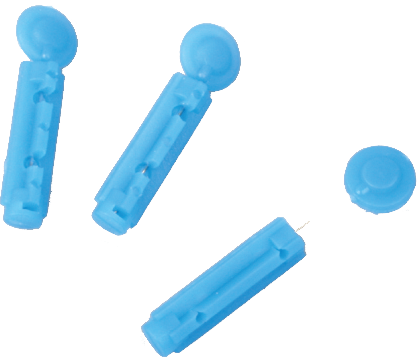
Ref No.: NME000201
Health care providers and people with diabetes rely on lancets to draw blood samples. Lancets are classified by the depth of penetration (skin puncture) they provide. Some lancets work better for testing fingersticks and some work better for a small sample from the side of the fingertip.
When it comes to choosing the right lancet device for your needs, there are a few things you need to take into consideration. First, you need to think about what type of lancet device you want. There are two main types of lancet devices: manual and automatic. Manual devices require you to manually insert the lancet into your skin, while automatic devices do not. If you have diabetes, your doctor will likely recommend that you use an automatic lancet device. These devices are less painful and less likely to cause infection than manual devices. Once you've decided on the type of lancet device you want, you need to choose the right size. Lancet sizes range from 28 gauge to 33 gauge. The smaller the number, the larger the needle on the device. If you're not sure what size you need, talk to your doctor or pharmacist. They can help you choose the right size based on your needs. Finally, you need to choose a brand of lancet device that you trust. There are many different brands on the market, so it's important to do some research before making your purchase. Once you've found a brand that you trust, stick with it for all of your future lancing needs.
It is important to take safety precautions when using a lancet device. These devices are sharp and can cause injuries if not used properly. Here are some tips to help you stay safe:
-Wash your hands thoroughly before handling the device.
-Be sure to use the device on clean, dry skin.
-Puncture the skin at a 90 degree angle.
-Do not press too hard when puncturing the skin.
-After use, dispose of the lancet in a sharps container.
If you have diabetes, you know that checking your blood sugar levels is an important part of managing your condition. A lancing device is a small, hand-held tool that helps you get a drop of blood from your finger for testing. Lancing devices vary in design, but most work in a similar way:
1. Insert a new lancet into the lancing device.
2. Adjust the puncture depth. shallower settings are less painful but may not produce enough blood for an accurate reading, while deeper settings may be more painful but will produce a larger drop of blood.
3. Place the lancing device on your fingertip and push the button to release the lancet.
4. Gently squeeze your finger to produce a drop of blood, then place the drop on a test strip for your glucose meter.
5. Dispose of the used lancet properly. With proper care and maintenance, your lancing device should last for many years. Be sure to follow the manufacturer's instructions for use and care to get the most out of your device
After you've used your lancet device, it's important to clean it up properly. First, remove the lancet from the device and dispose of it in a sharps container. Then, wipe down the device with a alcohol swab or another disinfecting agent. Be sure to get all of the nooks and crannies, as well as any visible blood. Once you're satisfied that the device is clean, put on a new lancet and store it in a safe place until your next use.
If you're like most people, you probably don't know how to use a lancet device. Here are some tips and tricks to help you get the most out of your lancet device:
1. Use the right size lancet for your finger. If the lancet is too big, it will be difficult to insert and may cause pain. If the lancet is too small, it may not puncture the skin deep enough to get a good sample of blood.
2. Insert the lancet into your finger at a 45 degree angle. This will help ensure that the lancet punctures the skin deeply enough to get a good sample of blood.
3. Apply pressure to the side of the lancet with your thumb as you push it into your finger. This will help prevent pain from the lancet puncturing your skin.
4. Once the lancet is in place, release the pressure on the side of the lancet and allow it to spring back out of your finger. This will help ensure that you get a good sample of blood without causing pain or damage to your finger.